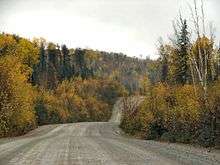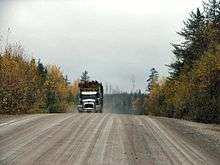Sultan Industrial Road
The Sultan Industrial Road, also sometimes unofficially known as Ramsey Industrial Road,[3] is a private road in the Canadian province of Ontario. Originally built as a resource route for E. B. Eddy's logging and lumber operations in the northwestern Sudbury District, the road is now owned and operated by Eacom Timber.[4] It is under a public access agreement with the province, permitting its use for public travel.[4]
| Sultan Industrial Road | |
|---|---|
| Route information | |
| Length | 79.7 km[1] (49.5 mi) |
| Existed | September 19, 1978[2]–present |
| Major junctions | |
| West end | 47°35′25″N 82°45′39″W |
| East end | 47°28′21″N 81°50′51″W |
| Location | |
| Towns | Sultan |
| Highway system | |
| Roads in Ontario | |
Route description

The road, which has a gravel surface, begins at the intersection of Highway 144 and Highway 560, 96 km (60 mi) north of Cartier and 32 kilometres (20 mi) south of Gogama. It travels westward through remote forests to the terminus of Highway 667 at Sultan approximately 80 km (50 mi) to the west. The road is one of the only intersections along Highway 144 apart from its termini. The route also provides the only terrestrial road access to the community of Biscotasing and the ghost towns of Jerome Mine and Ramsey. It has a speed limit of 70 kilometres per hour (43 mph), as defined in Ontario Regulation 681;[5] however, logging trucks routinely travel in excess of 110 km/h and so caution is advised.[1]
A traffic study on the road in 2016 found that 45 per cent of the vehicles using the road were passenger cars.[4]

History
The Sultan Industrial Road was initially constructed by the private logging company, E.B. Eddy Forest Products Limited. On September 19, 1978, an agreement was signed between the company and the Ministry of Transportation and Communications, predecessor to the Ministry of Transportation. This agreement opened the road for public use under the maintenance of the company.[2] The road has remained unchanged since, with the exception of the responsibility for its maintenance, which is now under the jurisdiction of Eacom.[4]
In the 1990s, provincial MPP Floyd Laughren lobbied for the road to be fully paved, and secured a commitment from the Ministry of Transportation to do so shortly before the 1995 election; however, following the election the plan was cancelled by the new government of Mike Harris.[4] Many municipal politicians and media commentators in the area have also lobbied for the road to be upgraded to full provincial highway status,[6] as the route would reduce the length of a trip from Sudbury to Wawa by fully 100 kilometres (62 mi) compared to the current routing of Highway 17,[1] and would provide an alternate route for traffic in the event of a closure of Highway 17's Montreal River Hill segment.[3]
Major intersections
The following table lists the major junctions along Sultan Industrial Road.[1] The entire route is located in Sudbury District.
| Location | km[1] | mi | Destinations | Notes | |
|---|---|---|---|---|---|
| Sultan | 0.0 | 0.0 | |||
| Unorganized Sudbury | 23.2 | 14.4 | Dore Road | Dore Road is the only named road between the two termini of the route | |
| 79.7 | 49.5 | ||||
| 1.000 mi = 1.609 km; 1.000 km = 0.621 mi | |||||
References
- Google (February 15, 2014). "Sultan Industrial Road - length and route" (Map). Google Maps. Google. Retrieved February 15, 2014.
- "Sultan–Makwa Road opened to public traffic" (Press release). Ministry of Transportation and Communications. September 19, 1978.
- "The Montreal River hill: Nine years for nothing?". Northern Ontario Business, May 16, 2006.
- "The public-private road: logging trucks and road trippers share the Sultan Industrial Road". CBC Sudbury, July 9, 2017.
- Speed Limits in Territory without Municipal Organization, R.R.O. 1990, Reg. 621 at the Canadian Legal Information Institute.
- Doug Millroy, "Upgrade Sultan road as route to Wawa". Sault Star.